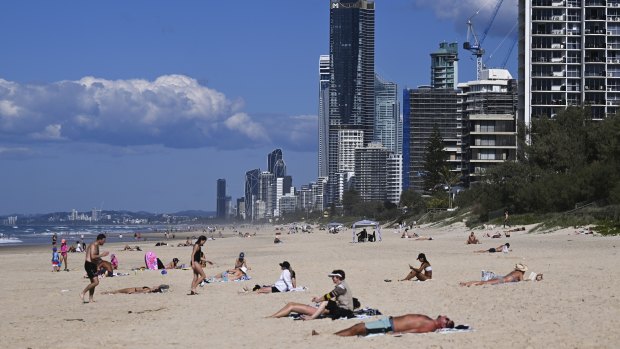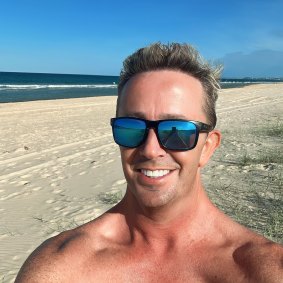- Exclusive
- National
- Queensland
- Population
This was published 1 year ago
Southern swell: Why Queensland is attracting so many migrants from NSW and Victoria
By Matt Wade, Craig Butt and Courtney Kruk
At least one in 10 residents in many beachfront Gold Coast and Sunshine Coast suburbs moved there from NSW or Victoria during the five years to 2021 as part of an exodus from southern states into south-east Queensland.

Around 7 per cent of the Gold Coast population moved there from NSW and Victoria between 2016 and 2021. Credit: Photo: Brisbane Times
In Coolangatta, on the NSW border, 18.6 per cent of the population moved up from the two big southern states between 2016 and 2021 – the highest share of any Queensland neighbourhood, according to the analysis of census figures by Brisbane Times.
Other parts of the Gold Coast attracting new residents were Mermaid Beach-Broadbeach (11.4 per cent), Currumbin-Tugun (10.4 per cent), Surfers Paradise (9.6 per cent) and Burleigh Heads (8.3 per cent).
Many traded coastal lifestyles in Sydney for warmer waters north of the border – including health insurance sales manager Michael Harris.
The 46-year-old grew up in Sydney and spent most of his adult life living in Randwick.
After a brief stint in the Blue Mountains, he moved with his partner to the Gold Coast in early 2022.
“I used to go up to the Gold Coast every year … and I just loved it,” Harris said.
“When I got offered the opportunity to work [from home] and be able to live on the Gold Coast, we jumped at it.”

46-year-old Michael Harris moved to the Gold Coast at the start of 2022. Credit: Michael Harris
Lifestyle was the main reason the pair wanted to move interstate.
“It’s so much more laid back,” Harris said. “I’ve got literally everything, whether it be hospitals, shopping centres or restaurants, all within 10 minutes.
“No way would I ever go back to Sydney.”
The beachside neighbourhood of Cronulla was the top source of arrivals to the Gold Coast from the NSW capital over the five-year period, with 206 people making the move.
It was followed by Dee Why-North (200), Manly-Fairlight (189) and Bondi Beach-North Bondi (180).
The neighbourhoods of Prahran-Windsor (99), Carrum-Patterson Lakes (95) and Point Cook East (92) were the source of most new Gold Coast residents from Melbourne.
KPMG urban economist Terry Rawnsley said the warm climate in south-east Queensland coupled with relatively affordable housing had underpinned the population flow from NSW and Victoria.
“That housing affordability draw is definitely part of it,” he said.
“You can cash in your property in Brighton or Bondi and get something cheaper and/or larger in Burleigh Heads or Noosa.”
Social researcher Mark McCrindle said greater acceptance of flexible employment arrangements since the COVID-19 pandemic, especially work from home, had been another driver of interstate migration.
“A move to Queensland while keeping a southern city job is now much more viable,” he said.
The analysis reveals nearly 50,000 shifted to the Gold Coast from NSW and Victoria between 2016 and 2021.
Sea changers from these southern states now make up about 7 per cent of the Gold Coast’s population – or about one in every 14 people.
A big source of new Gold Coast residents were NSW towns and suburbs close to the Queensland border including Tweed Heads, Banora Point and Kingscliff.
It was a similar story on the Sunshine Coast, where about 6 per cent of the current population moved there from NSW and Victoria during the five years to 2021.
The biggest influx was to Peregian Springs (14.4 per cent), Noosa Heads (13 per cent) and Noosaville (11 per cent).
Sydney’s northern beaches were the biggest source of departures to the Sunshine Coast from the NSW capital over this period, led by Mona Vale-Warriwood (161 people), Freshwater-Brookvale (149) and North Narrabeen (137).
Nearly 15,000 people shifted to the Sunshine Coast from NSW and just over 10,000 moved there from Victoria.
The influx of population from NSW and Victoria has contributed to robust population growth in south-east Queensland.
The Sunshine Coast’s population jumped by 15.1 per cent between 2016 and 2021 – way above the national growth rate of 8.6 per cent during that period.
The Gold Coast grew by 12.4 per cent between 2016 and 2021 while Greater Brisbane’s population rose by 11.2 per cent in the period.
Last year Queensland had a net inflow of 34,545 people due to interstate migration while NSW had a net outflow to other states of 31,560 and Victoria had a net outflow to other states of 9955.
That helped Queensland’s population grow by 2.2 per cent last year, well above the national growth rate of 1.9 per cent.
Parts of inner Brisbane have also attracted a significant share of new residents from NSW and Victoria during the past five years, especially Bulimba (7.9 per cent), Enoggera (6.9 per cent) and Hawthorne (6.6 per cent).
Almost 35,000 people moved from NSW to Brisbane between 2016 and 2021, census figures show.
Rawnsley said Brisbane offered housing at a “cheaper price point” than the southern capitals, which had helped attract young well-educated workers, especially those working in the city’s professional services sector.
“If you put Brisbane, Sydney and Melbourne together, there’s a demographic that wants a coastal lifestyle, there’s a demographic that wants an inner-city lifestyle and there’s a group that wants a new house on a bigger block – on affordability Brisbane wins out on all those fronts,” he said.
Get the inside word on the news, sport, food, people and places Brisbane is talking about. Sign up for our City Talk newsletter.